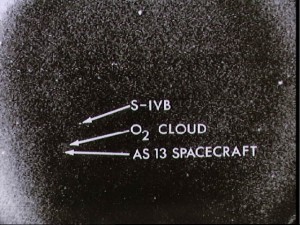Apollo 13: Eyewitness to the Explosion
“Odyssey, You Have a Problem”
/https://tf-cmsv2-smithsonianmag-media.s3.amazonaws.com/filer/77/51/7751d4eb-2960-492c-a8e1-208ced1b4548/apollo_13_passing_moon.jpg)
Odyssey, you have a problem.
If five men in Houston had realized what they were seeing through a telescope on the evening of April 13, 1970, they could have radioed those words to the crew of Apollo 13, who was still trying to grasp what had just happened: an oxygen tank on their spacecraft had exploded en route to the moon.
George Wyckliffe Hoffler was at the time a young NASA flight surgeon assigned to study cardiovascular data gathered from the Apollo astronauts during their spaceflights. On the second night of the mission, Hoffler was taking a break from studying for his medical boards, and had joined four other NASA employees on the roof of building 16A at the Manned Spacecraft Center, now the Johnson Space Center. There they watched a television monitor hooked up to a 16-inch Schmidt-Cassegrain telescope with a television camera mounted in place of the eyepiece. The monitor showed two dots flying in formation on their way to the moon: the brighter of the two was the spent third stage of the Saturn V launch vehicle; the dimmer one was the Apollo 13 spacecraft, which had separated from the third stage two days earlier.

Every ten seconds the TV camera integrated, or updated, the image. "Between one ten-second integration and the next one," says Hoffler, now retired in Titusville, Florida, "we can't say exactly what second that was, the less bright dot was not a dot anymore. It was an expanded sphere, reflecting light. A disc. And I remember the guy who was in charge of the thing, Andy Saulietis,...he said, 'What in the world is that?' Every ten seconds it continued to grow a bit, and then started to fade as the gas dissipated into the vacuum of space. We watched it for two or three minutes I guess. In retrospect, none of us had the presence of mind to call next door to Mission Control and say, 'Hey guys, you've got a problem.' "
What they were seeing was oxygen from the ruptured tank venting into space. In the vacuum, there was no atmospheric pressure to contain the expanding vapor. "We calculated the diameter of that reflecting sphere of gas surrounding the spacecraft to be approximately 25 miles. And it just blew out in just a few seconds," says Hoffler. "It was under pressure, and when the cannister blew, the gas molecules jetted out with enormous velocity." In this extended recording, astronauts Jim Lovell, Jack Swigert and Fred Haise remain calm as they report various readings to mission control. Lovell finally looks out the window to say that he sees some sort of gas being vented into space.
Hoffler notes that the anniversary of Apollo 13, which launched on April 11, overlaps with the April 12 anniversary of Yuri Gagarin's flight as the first human in space in 1961, as well as the first flight of the space shuttle, launched on April 12, 1981. When offered the suggestion that April was a good month for human spaceflight, he says: "It was a bad month too."